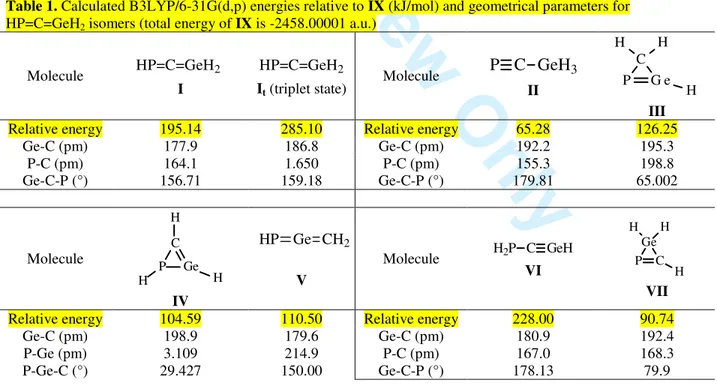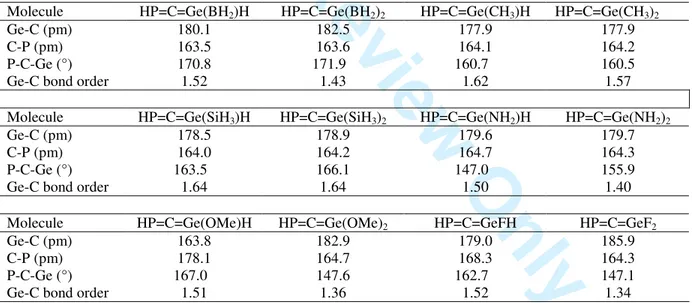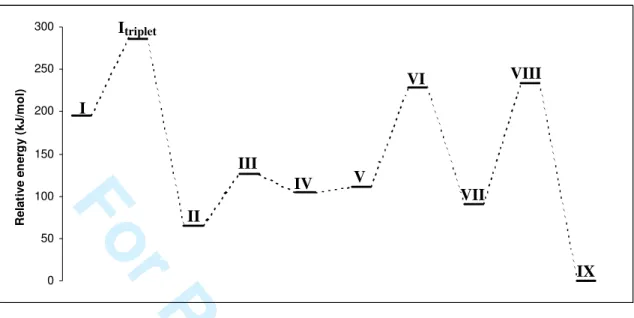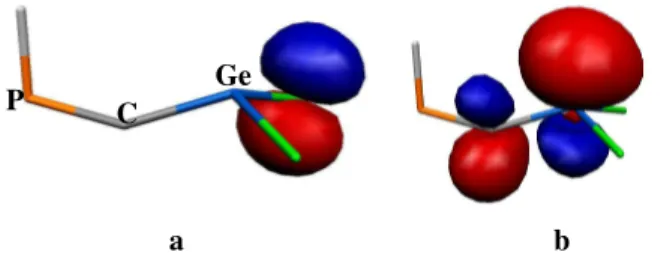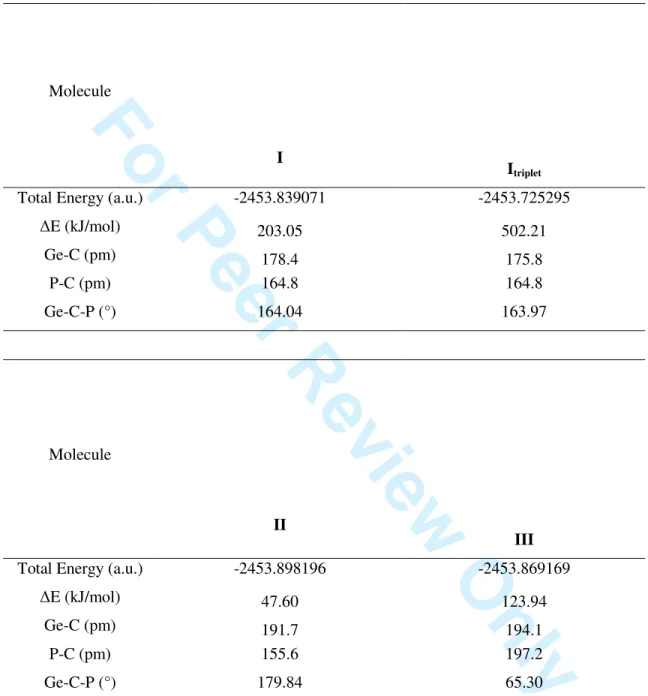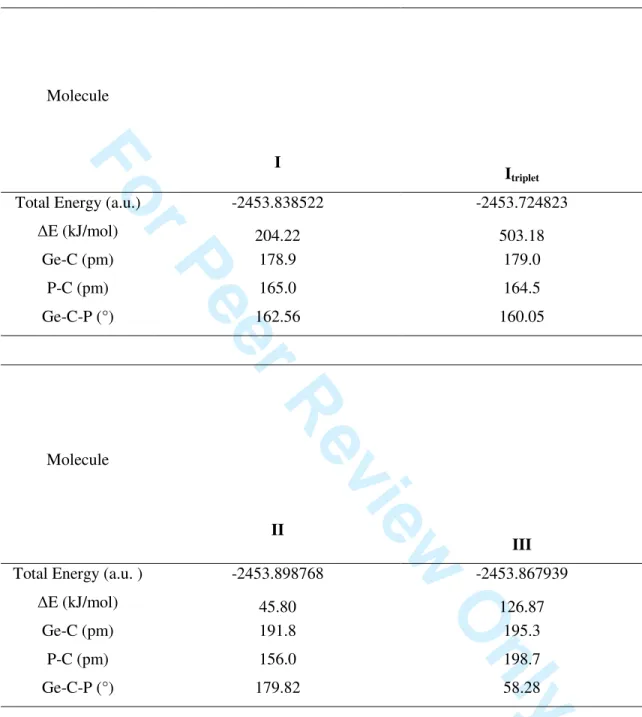HAL Id: hal-00513258
https://hal.archives-ouvertes.fr/hal-00513258
Submitted on 1 Sep 2010HAL is a multi-disciplinary open access archive for the deposit and dissemination of sci-entific research documents, whether they are pub-lished or not. The documents may come from teaching and research institutions in France or abroad, or from public or private research centers.
L’archive ouverte pluridisciplinaire HAL, est destinée au dépôt et à la diffusion de documents scientifiques de niveau recherche, publiés ou non, émanant des établissements d’enseignement et de recherche français ou étrangers, des laboratoires publics ou privés.
Ioan Silaghi-Dumitrescu, P. M. Petrar, G. Nemes Nemes, J. Escudiéb, H.
Ranaivonjatovob
To cite this version:
Ioan Silaghi-Dumitrescu, P. M. Petrar, G. Nemes Nemes, J. Escudiéb, H. Ranaivonjatovob. An Insight into the Structure of Model Germaphosphaallenes. Molecular Physics, Taylor & Francis, 2009, 107 (08-12), pp.1161-1167. �10.1080/00268970902780288�. �hal-00513258�
For Peer Review Only
An Insight into the Structure of Model Germaphosphaallenes
Journal: Molecular Physics Manuscript ID: TMPH-2008-0403.R1
Manuscript Type: Special Issue Paper - Fritz Schaefer Date Submitted by the
Author: 25-Jan-2009
Complete List of Authors: Silaghi-Dumitrescu, Ioan; Universitatea Babes-Bolyai, Department of Chemistry
Petrar, P. M.; Babes-Bolyai University Nemes, G. Nemes; Babes-Bolyai University
Escudiéb, J.; Hétérochimie Fondamentale et Appliquée, (UMR CNRS 5069)
Ranaivonjatovob, H.; Hétérochimie Fondamentale et Appliquée, (UMR CNRS 5069)
Keywords: phosphagermaallenes, B3LYP, CCSD, MP4, theoretical study
For Peer Review Only
An Insight into the Structure of Model Germaphosphaallenes
P. M. Petrar
a,b, G. Nemes
a, I. Silaghi-Dumitrescu
*a, J. Escudié
b,H. Ranaivonjatovo
b aBabes-Bolyai University, Cluj-Napoca, Romania; b Hétérochimie Fondamentale et Appliquée UniversitéPaul Sabatier, Toulouse, France
The geometries of all possible isomers of the model compound H2Ge=C=PH were optimized at the
B3LYP/6-31G(d,p) level of the theory. The calculation were repeated at higher correlated methods with similar results and for the the isomers of the methyl-substituted phosphagermaallene MeP=C=GeMe2. As
another way to stabilise the P=C=Ge unit consists in the use electronic effects, a NBO study was carried out in order to identify the influence that the nature (electropositive or electronegative) of several substituents would have on the strength of the C=Ge bond. Model compounds HP=C=GeR2 and HP=C=GeRR’ were
investigated (R = BH2, CH3, SiH3, NH2, OMe, F; R’ = H). It was found that the main interaction
contributing to the weakening of the C=Ge bond is a transfer of electron density from the lone pair of the phosphorus atom to the molecular antibonding orbital localized on the Ge-C bond.
Keywords: phosphagermaallenes, B3LYP, CCSD, MP4, theoretical study
I. Introduction
The chemistry of allene analogues of group 14 elements has been in the focus of the scientific community for more than three decades, since the synthesis of the first silaallene by Brook et
alter [1].Our group has been interested mainly in the synthesis, characterizations and reactivity of phosphaallenes in which one of the carbon atom is formally replaced with heavy group 14 elements, like Si, Ge and Sn [2-4].
A general synthetic route towards phosphagermaallene has been established by our group [3] and it includes the dehalogenation of 2,3-dihalo-1-phospha-3-germa-1-propenes by means of a lithium reagent. While several precursors of this type have been synthesized [5, 6 ], the choice of the appropriate organic groups on both the phosphorus and the germanium atoms plays an important role in the outcome of the reaction, as it has been shown by us previously [7, 8, 9].
A transient phosphagermaallene [8] has been evidenced and the synthesis of the first stable phosphagermaallene, Mes*P=C=Ge(tBu)(Tip) (Mes* = 2, 4, 6-tri-tert-butyl-phenyl, Tip = 2, 4, 6-tri-iso-propyl-phenyl) has been carried out recently bu our group [9]. These compounds have been characterized through the usual spectroscopic methods (NMR, IR), but their instability makes computational chemistry a useful tool in the study of their structure and properties, providing the means to investigate them. However, there is only a limited number of papers dealing with theoretical aspects of phosphagermallenes chemistry. Thus, Escudié et.al. rationalized [8] the dimerization outcome of Mes*P=C=GeMe2. Their RHF study shows that, the
*
Corresponding author. Email : isi@chem.ubbcluj.ro
3 4 5 6 7 8 9 10 11 12 13 14 15 16 17 18 19 20 21 22 23 24 25 26 27 28 29 30 31 32 33 34 35 36 37 38 39 40 41 42 43 44 45 46 47 48 49 50 51 52 53 54 55 56 57 58
For Peer Review Only
head-to-head dimerization of two Ge=C bonds is favoured, in contrast with the experimentally observed formation of four-atom rings from head-to-tail dimerization involving two double Ge=C bonds or a head-to-tail P=C and a Ge=C dimerization (forming new P-C and Ge-C bonds) [8]. Note however that the most important calculated difference in energy between the head-to head and head-to-tail dimers was around 24 kJ/mol. Due to the experimental use of very bulky mesityl (2,4,6-tri-methyl-phenyl) and supermesityl groups, the discrepancy with the model calculations is not surprising since the large steric hindrance of substituents disfavor the head-to-head dimers.
In the present work, a theoretical study on model compounds of phosphagermaallenes has been carried out, in order to further characterize such derivatives and also to rationalize the small number of such derivatives described to date.
II. Results and discussions
II.1. Structural minima of model 1-3-phosphagermaallenes – a B3LYP/6-31G(d,p) study The geometries of all possible isomers of the model compound PCGeH3 were optimized at the
B3LYP/6-31G(d,p) [10-13] level of the theory, using the Spartan package of programs [14]. A vibrational analysis was also carried out in order to ensure that all the geometries found correspond to minima. The triplet state of the phosphagermaallene was also investigated in order to see whether the preference for the single state is kept while going from >Ge=C< to >Ge=C=P- skeletons. The energy data and results relevant geometrical parameters are given in Table 1.
Table 1. Calculated B3LYP/6-31G(d,p) energies relative to IX (kJ/mol) and geometrical parametersfor HP=C=GeH2 isomers (total energy of IX is -2458.00001 a.u.)
Molecule HP=C=GeH2 I HP=C=GeH2 It (triplet state) Molecule P C GeH3 II P G e C H H H III
Relative energy 195.14 285.10 Relative energy 65.28 126.25 Ge-C (pm) 177.9 186.8 Ge-C (pm) 192.2 195.3 P-C (pm) 164.1 1.650 P-C (pm) 155.3 198.8 Ge-C-P (°) 156.71 159.18 Ge-C-P (°) 179.81 65.002 Molecule P Ge C H H H IV CH2 Ge HP V Molecule H2P C GeH VI P C Ge H H H VII
Relative energy 104.59 110.50 Relative energy 228.00 90.74 Ge-C (pm) 198.9 179.6 Ge-C (pm) 180.9 192.4 P-Ge (pm) 3.109 214.9 P-C (pm) 167.0 168.3 P-Ge-C (°) 29.427 150.00 Ge-C-P (°) 178.13 79.9 3 4 5 6 7 8 9 10 11 12 13 14 15 16 17 18 19 20 21 22 23 24 25 26 27 28 29 30 31 32 33 34 35 36 37 38 39 40 41 42 43 44 45 46 47 48 49 50 51 52 53 54 55 56 57 58 59
For Peer Review Only
Molecule H2P Ge CH VIII P Ge CH3 IX Relative energy 233.68 0 Ge-C (pm) 172.7 196.7 P-Ge (pm) 235.9 202.4 P-Ge-C (°) 122.19 179.897Thus, the following trend among the relative energies of isomers of H3PCGe is observed (Figure 1):
Figure 1. Relative energies (compared to the series minimum IX) of H3PCGe isomers
Unexpectedly, the most stable isomer is IX, containing the P≡Ge triple bond. This comes as a surprise, considering that the instability of multiple bonded germanium derivatives usually increases with the degree of unsaturation, and the isomer containing the P=Ge bond is thermodynamically less stable than IX. In fact, our results are in agreement with previous calculations data on organometallic compounds, where phosphorus-germanium triple bonds are computed to be energetically more favored than the germanium-phosphorus double bonds [15, 16]. Electronegative substituents on the germanium atom increase the strength of the triple bond, while those with lower electronegativity weaken it. The reason for which triple bonded germanium compounds are so scarce (and there are no known derivatives containing the P≡Ge unit reported up to date) must be of kinetical nature; as the use of bulky substituents providing a proper steric protection could lead to the isolation of such derivatives.
Since experimentally we start from the P=C-Ge skeleton to synthesize 1-3-phosphagermaallenes, we were more interested in the isomers containing the P-C-Ge sequence. The phosphagermirene IV is theoretically more likely to form than the phospagermaallene I, but no such compound has been previously reported so far. The difference of about 83.74 kJ/mol between the energies of V and I can be easily covered by the ring opening of the cycle to afford the linear structure.
From all the model-compounds given in Table 1, only VII has a precedent [17] in the literature to be characterized by X-ray crystallography (VIIa), and the present DFT method affords very close geometrical parameters (see Scheme 1), indicating that this computational method is accurate enough in describing such derivatives.
3 4 5 6 7 8 9 10 11 12 13 14 15 16 17 18 19 20 21 22 23 24 25 26 27 28 29 30 31 32 33 34 35 36 37 38 39 40 41 42 43 44 45 46 47 48 49 50 51 52 53 54 55 56 57 58
For Peer Review Only
Ge P C H H H Ge P C CH(SiMe3)2 tBu CH(SiMe3)2 192.4 193.2 229.9 166.2 232.6 VII VIIa 168.3Scheme 1. Bond lengths for VII (calculated) and VIIa (obtained from X-ray data)
The bent geometry obtained for I is not surprising for such compounds, since heavier group 14 elements are known to prefer a bent structure when involved in multiple bonding [18]. This is in sharp contrast however with the geometry of H2C=C=CH2 allene and heavier analogues
resulted by substitution of carbon for silicon, or germanium (H2Si=Si=SiH2, H2Ge=Ge=GeH2,
H2Si=C=GeH2, H2Ge=C=GeH2) which are all optimized to a linear skeleton at the
B3LYP/6-31G(d) method. A molecular orbital analysis of I reveals that the frontier orbitals have a pronounced antibonding character between the phosphorus and carbon atom in the P=C=Ge unit. The HOMO is mainly localized on the Ge=C double bond (Figure 2).
Figure 2. HOMO (a) and LUMO (b) orbitals of H2Ge=C=PH I
The same shapes of the frontier orbitals are also found for all the other isomers, the HOMO being mainly localized on the Ge-C bond, while the LUMO has an even more pronounced antibonding character (with three nodal planes) and is localized on the P-C fragment. The HOMO-LUMO separation for I is more than 4 eV. This gap is smaller for the cyclic structures III and IV (3 eV), but increases again for VII, which indicates that the isolation of VIIa is partially due to its smaller kinetical liability compared to the other isomeric rings. The use of sterically hindering substituents on the germanium and phosphorus atoms should afford the stabilization needed for the linear structure. With this in mind, we have slightly increased the steric congestion on the P-C-Ge unit, performing calculations on the isomers of the model phosphagermaallene MeP=C=GeMe2 at the same DFT level. The results are given in Table 2.
Table 2. Calculated B3LYP/6-31G(d,p) parameters for MeP=C=GeMe2 isomers. Energies (kJ/mol are
given relative to lowest calculated total energy for isomer II (-2575.95922 a.u.).
Molecule I-Me3 It-Me3 (triplet) Molecule II-Me3 III-Me3
Relative energy 137.60 230.95 Relative energy 0.00 110.54 Ge-C (pm) 177.1 188.3 Ge-C (pm) 194.2 196.8
P-C (pm) 163.8 164.6 P-C (pm) 155.6 201.6 Ge-C-P (°) 167.478 157.945 Ge-C-P (°) 179.837 64.457
Molecule IV-Me3 V-Me3 Molecule VI-Me3 VII-Me3 3 4 5 6 7 8 9 10 11 12 13 14 15 16 17 18 19 20 21 22 23 24 25 26 27 28 29 30 31 32 33 34 35 36 37 38 39 40 41 42 43 44 45 46 47 48 49 50 51 52 53 54 55 56 57 58 59
For Peer Review Only
Relative energy 74.48 115.44 Relative energy 174.95 35.37 Ge-C (pm) 199.7 187.4 Ge-C (pm) 183.4 193.3 P-Ge (pm) 3.070 217.6 P-C (pm) 164.2 169.8 P-Ge-C (°) 30.709 123.202 Ge-C-P (°) 158.911 79.415
Molecule VIII-Me3 IX-Me3
Relative energy 89.55 31.37 Ge-C (pm) 175.2 202.6 P-Ge (pm) 240.7 202.9 P-Ge-C (°) 105.366 179.999
It can be noticed that the most stable isomer is isomer II, but that the more stericaly hindered MeP=C=GeMe2 I-Meis more stable by comparison with the HP=C=GeH2 analogue, the
energy difference between I and IX being 195.27 kJ/mol for the former and 105.97 kJ/mol for the latter. This is in line with the experimental observation that increasing hindrance around the Ge=C=P unit by using very bulky groups (like Mes, Tip, tBu or Mes*) affords longer lifetime to allow the isolation of phosphagermaallenes [9].
There are no significant changes in the form of the frontier orbitals going from H2Ge=C=PH to Me2Ge=C=PMe proving that the basic electronic effects are those determined by
the H2GeCPH skeleton
II.2. Investigations of model phosphagermaallenes isomers through higher level correlation methods
To improve the treatment of electron correlation, and to check the validity of the DFT treatment geometry optimizations have also been run at the CCSD/6-31G(d, p) [19-22] and MP4(SDQ)/6-31G(d, p) [23] levels of the theory using Gaussian 98 [24]. The calculated energies are given in Table 3.
Table 3. Calculated CCSD/6-31G(d, p) and MP4/6-31G(d, p) energies (a.u.) for the phosphagermaallene
isomers I-IX
Molecule I It triplet II III IV
CCSD/6-31G(d,p) -2453.83907 -2453.72529 -2453.89820 -2453.86917 -2453.86749
MP4/6-31G(d,p) -2453.83852 -2453.72482 -2453.89877 -2453.86794 -2453.86626
Molecule V VI VII VIII IX
CCSD/6-31G(d,p) -2453.86956 -2453.81166 -2453.88406 -2453.82308 -2453.91630
MP4/6-31G(d,p) -2453.86851 -2453.80834 -2453.88359 -2453.81987 -2453.91620
The correlation methods give similar geometries and relative energies (see the Supplementary
Information) to those found by DFT, as isomer IX is calculated to be the most stable one. However the cyclic structures have lower relative energies than those calculated at the B3LYP level. It is worth to note here that the DFT methods (particularly B3LYP also) predict lower 3 4 5 6 7 8 9 10 11 12 13 14 15 16 17 18 19 20 21 22 23 24 25 26 27 28 29 30 31 32 33 34 35 36 37 38 39 40 41 42 43 44 45 46 47 48 49 50 51 52 53 54 55 56 57 58
For Peer Review Only
energy for H2C=C=CH2 than for the propyne isomer (HC≡C-CH3 [25, 26] in contrast with
experiment and results obtained at explicitly correlated methods (MP2 and CCSD(T)) with
various basis sets
[26]. The present B3LYP calculations on the heavier allene type systems supported by the results at the CCSD and MP4 levels increase the reliability of the DFT-B3LYP method in describing the properties of such systems.II.3. The influence of substituents on Ge - a measure for the stability of the P=C=Ge unit The role of electronic effects of substituents in stabilizing systems containing the P=C=Ge unit has not been assessed so far. If voluminous ligands (which block or decrease the reactivity of the protected double bond) could be replaced by smaller substituents inducing electronic stabilization (i..e larger HOMO-LUMO gaps) the properties of this allenic core could be (at least in theory) tuned by using different types of substituents.
This study aims to identify the influence that the nature (electron withdrawing or releasing) of several substituents would have on the strength of the C=Ge bond in the P=C=Ge unit. The analysis is based on a treatment using the NBO 3.1 program [27] incorporated in Gaussian 98.
The C=Ge and C=P bond lengths found for H2Ge=C=PH by a B3LYP/6-311G(d,p)
geometry optimization are 178 pm and 1.64 pm, respectively. These values are in agreement with experimental data: a 178 pm bond length was reported for Ge=C in a 1-germaallene [28]. The P=C bond in phosphaallenes is usually slightly shorter than 164 pm, as expected from the sp hybridization of the C atom [2]. The P=C=Ge unit in the model compound is not linear, as it is the case for carbon-allenic structures; the GeCP angle has a value of 160.4°. The NBO analysis performed on the optimized structure I indicates a sp hybridization for the carbon atom, together with the expected sp2 hybridization for the germanium. The reason for the calculated deviation from linearity seems to be an hyperconjugation effect involving donation of electron density from the phosphorus lone pair to the antibond orbital localized on the Ge-C bond (Figure 3a). This is shown by the second order perturbation analysis of the Fock matrix in the NBO basis (see the relevent part of the output file in the Supplemental Information Section). Such interactions can also account for a smaller bond order than 2, as the calculated Wiberg bond index [29] for the Ge=C bond is 1.6575. Figure 3b,c shows the shape of the lone pair orbital (LP) on the phosphorus and the σ-antibond orbital on the Ge-C atom. Note that the LP bearing orbital matches the phase of σ-antibond (red coloured in Figure 3c), and this interaction is enhanced by the bending of the PCGe skeleton. 3 4 5 6 7 8 9 10 11 12 13 14 15 16 17 18 19 20 21 22 23 24 25 26 27 28 29 30 31 32 33 34 35 36 37 38 39 40 41 42 43 44 45 46 47 48 49 50 51 52 53 54 55 56 57 58 59
For Peer Review Only
Figure 3. Lone-pair- σ* hyperconjugation in the case of the P=C=Ge unit (a) between the P lone pair (b)
and the σ* orbital on the Ge-C bond (c) in the case of HP=C=GeH2
Another significant interaction with the same effect in the decrease of the Ge-C bond order is a charge transfer from a P-H bonding orbital to the π-symmetry antibond orbital on the Ge-C bond (Figure 4a).
Figure 4. σ-π* interaction (a) between the P-H bond orbital (b) and the Ge-C antibonding NB orbital (c) in
the model phosphagermaallene HP=C=GeH2
The effect that different substituents containing group 13 to 17 elements on the germanium atom would have on the bond order of the Ge-C bond in phosphagermaallenes has been investigated by B3LYP/6-311G(d, p) calculations on the model compounds shown in Table 5.
Table 5. B3LYP/6-311G(d,p)geometrical data and Wiberg bond indexes for model phosphagermaallenes
Molecule HP=C=Ge(BH2)H HP=C=Ge(BH2)2 HP=C=Ge(CH3)H HP=C=Ge(CH3)2
Ge-C (pm) 180.1 182.5 177.9 177.9
C-P (pm) 163.5 163.6 164.1 164.2
P-C-Ge (°) 170.8 171.9 160.7 160.5
Ge-C bond order 1.52 1.43 1.62 1.57
Molecule HP=C=Ge(SiH3)H HP=C=Ge(SiH3)2 HP=C=Ge(NH2)H HP=C=Ge(NH2)2
Ge-C (pm) 178.5 178.9 179.6 179.7
C-P (pm) 164.0 164.2 164.7 164.3
P-C-Ge (°) 163.5 166.1 147.0 155.9
Ge-C bond order 1.64 1.64 1.50 1.40
Molecule HP=C=Ge(OMe)H HP=C=Ge(OMe)2 HP=C=GeFH HP=C=GeF2
Ge-C (pm) 163.8 182.9 179.0 185.9
C-P (pm) 178.1 164.7 168.3 164.3
P-C-Ge (°) 167.0 147.6 162.7 147.1
Ge-C bond order 1.51 1.36 1.52 1.34
The largest bond order is calculated for substituents containing group 14 elements, like CH3 and SiH3. The calculation was also carried out for a phosphagermaallene bearing a SiMe3
group on the germanium atom to check if the Si-H bond is not the one determining the higher bond order through stabilizing hyperconjugation effects towards the Ge=C unit, and also because SiH3 would make a poor experimental choice. The results for HP=C=Ge(SiMe3)2 were similar to
those obtained for HP=C=Ge(SH3)2 with a calculated Wiberg bond order of 1.6396. The most
3 4 5 6 7 8 9 10 11 12 13 14 15 16 17 18 19 20 21 22 23 24 25 26 27 28 29 30 31 32 33 34 35 36 37 38 39 40 41 42 43 44 45 46 47 48 49 50 51 52 53 54 55 56 57 58
For Peer Review Only
important interaction that leads to the decrease in the Ge=C bond strength remains the donation of electron density from the P lone pair to the antibond orbital oriented on the Ge-C bond.
The low bond order in the case of the model compound HP=C=GeF2 is explained by
supplementary interactions due to the presence of the fluorine atom, bearing electron lone pairs (Figure 5).
Figure 5. Non-bonding orbitals involved in hyperconjugation leading to Ge=C destabilization in
HP=C=GeF2 (a) lone pair on F, b) π* orbital on the Ge-C bond)
The NBO analysis shows a strong delocalization the lone pair oriented perpendicular to the Ge-F bond to the π* orbital on the Ge-C bond and both fluorine atoms display this type of interaction. Figure 5 shows the shape of the orbitals involved. The other lone pair is oriented perpendicular to the π* orbital and cannot contribute to the mentioned hyperconjugative effect.
III. Outlook
The Ge=C bond in phosphagermaallenes is weakened by a hyperconjugative effect directed from the P lone pair to the Ge-C bonding orbital. Substituents with atoms bearing lone pairs or vacant p orbitals induce other types of charge transfer which also result in the weakening of the Ge=C bond order, while groups containing group 14 elements like Si and C are found to be “inert” and such substituents might stabilize the PCGe skeleton, still leaving access to the functionality of the double bonds.
Acknowledgments
The authors are grateful to Professor Romuald Poteau (Université Paul Sabatier, Toulouse) for helpful discussions. Financial support from the French Ministery of Foreign Affairs (ECO-NET program n° 18824SD) is acknowledged. We thank Dr. Joaquin Barosso-Flores for useful discussion on the NBO analysis.
Supplementary information on the MP4 and CCSD optimized geometries, geometrical data relative
energies and results on the second order perturbation NBO analysis is available at or on the request from the authors. 3 4 5 6 7 8 9 10 11 12 13 14 15 16 17 18 19 20 21 22 23 24 25 26 27 28 29 30 31 32 33 34 35 36 37 38 39 40 41 42 43 44 45 46 47 48 49 50 51 52 53 54 55 56 57 58 59
For Peer Review Only
References:
1. A. G. Brook, F. Abdesaken, B. Gutekunst, G. Gutekunst, R. K. Kallury, J. Chem. Soc., Chem. Commun., 191, (1981).
2. J. Escudié, H. Ranaivonjatovo, and L. Rigon, Chem. Rev., 100, 3639 (2000).
3. J. Escudié, H. Ranaivonjatovo, M. Bouslikhane, Y. El Harouch, L. Baiget, G. Cretiu Nemes, Russ. Chem. Bull., 53, 1020 (2004).
4. J. Escudié, H. Ranaivonjatovo, Organometallics, 26, 1542 (2007).
5. M. A. Chaubon, B. Dittrich, J. Escudie, H. Ramdane, H. Ranaivonjatovo, J. Satge, Synth. React. Inorg. Met-Org. Chem., 27, 519 (1997).
6. G. Nemes, J. Escudie, I. Silaghi-Dumitrescu, H. Ranaivonjatovo, L. Silaghi-Dumitrescu, H. Gornitzka, Organometallics, 26, 5136 (2007).
7. P. M. Petrar, G. Nemes, I. Silaghi-Dumitrescu, H. Ranaivonjatovo, H. Gornitzka, J. Escudié, Chem. Commun., 40, 4149 (2007).
8. H. Ramdane, H.Ranaivonjatovo, J. Escudié, S. Mathieu, and N. Knouzzi, Organometallics, 15, 3070 (1996).
9. Y. El Harouch, H. Gornitzka, H. Ranaivonjatovo, J. Escudié, J. Organomet. Chem., 643-644, 202 (2002).
10. A.D. Becke, J.Chem.Phys., 98, 5648 (1993).
11. C. Lee, W. Yang, and R.G. Parr, Phys. Rev. B, 37, 785 (1988). 12. S. H. Vosko, L. Wilk, and M. Nusair, Can. J. Phys., 58, 1200 (1980).
13. P. J. Stephens, F. J. Devlin, C. F. Chabalowski, and M. J. Frisch, J. Phys. Chem., 98, 11623 (1994).
14. Wavefunction Inc.18401 Von Karman Avenue, Suite 370 Irvine, CA 92612. 15. H. Basch, Inorg. Chim. Acta, 252, 265 (1996).
16. C.L. Chin-Hung Lai, M. Su, and S. Y. Chu, J. Phys. Chem. A, 106, 575 (2002). 17. A. H. Cowley, S. W. Hall, C. M. Nunn, and J. M. Power, Chem. Commun, 753 (1988). 18. Z. Rappoport, editor, The Chemistry of Organic Germanium, Tin and Lead Compounds, 2 vols., (John Wiley & Sons, 2002).
19. J. Cizek, Adv. Chem. Phys., 14, 35 (1969).
20. G. D. Purvis and R. J. Bartlett, J. Chem. Phys., 76, 1910 (1982).
21.G. E. Scuseria, C. L. Janssen, and H. F. Schaefer III; J. Chem. Phys., 89, 7382 (1988). 22. G. E Scuseria, H. F. Schaefer III, J. Chem. Phys., 90, 3700 (1989).
23 R. Krishnan, J. A. Pople, Int. J. Quant. Chem., 14, 91 (1978).
24. Gaussian 98, Revision A.6, M. J. Frisch, G. W. Trucks, H. B. Schlegel, G. E. Scuseria, M. A. Robb, J. R. Cheeseman, V. G. Zakrzewski, J. A. Montgomery, Jr., R. E. Stratmann, J. C. Burant, S. Dapprich, J. M. Millam, A. D. Daniels, K. N. Kudin, M. C. Strain, O. Farkas, J. Tomasi, V. Barone, M. Cossi, R. Cammi, B. Mennucci, C. Pomelli, C. Adamo, S. Clifford, J. Ochterski, G. A. Petersson, P. Y. Ayala, Q. Cui, K. Morokuma, D. K. Malick, A. D. Rabuck, K. Raghavachari, J. B. Foresman, J. Cioslowski, J. V. Ortiz, B. B. Stefanov, G. Liu, A. Liashenko, P. Piskorz, I. Komaromi, R. Gomperts, R. L. Martin, D. J. Fox, T. Keith, M. A. Al-Laham, C. Y. Peng, A. Nanayakkara, C. Gonzalez, M. Challacombe, P. M. W. Gill, B. Johnson, W. Chen, M. W. Wong, J. L. Andres, C. Gonzalez, M. Head-Gordon, E. S. Replogle, and J. A. Pople, Gaussian, Inc., Pittsburgh PA, 1998.
25. R. Kakkar, R. Garg, P. Chadha, J. Mol. Struct. (Theochem), 617, 141 (2002).
26. H. L. Woodcock, H. F. Schaefer, and P. R. Schreiner, J. Phys. Chem. A, 106, 11923 (2002). 27. NBO Version 3.1, E. D. Glendening, A. E. Reed, J. E. Carpenter, and F. Weinhold.
28. B. E. Eichler, D. R. Powell, and R. West, Organometallics, 17, 2147 (1998). 29. K.B. Wiberg, Tetrahedron, 24, 1083 (1968). 3 4 5 6 7 8 9 10 11 12 13 14 15 16 17 18 19 20 21 22 23 24 25 26 27 28 29 30 31 32 33 34 35 36 37 38 39 40 41 42 43 44 45 46 47 48 49 50 51 52 53 54 55 56 57 58
For Peer Review Only
Figure 1. Relative energies in kJ/mol (compared to the series minimum IX) of CH3GeP isomers
a b
Figure 2. HOMO (a) and LUMO (b) orbitals of HP=C=GeH2 I
Ge C P C Ge P 0 50 100 150 200 250 300 R e la ti v e e n e rg y ( k J /m o l) I Itriplet II III IV V VI VII VIII IX 3 4 5 6 7 8 9 10 11 12 13 14 15 16 17 18 19 20 21 22 23 24 25 26 27 28 29 30 31 32 33 34 35 36 37 38 39 40 41 42 43 44 45 46 47 48 49 50 51 52 53 54 55 56 57 58 59
For Peer Review Only
P C Ge H H H σ∗a
b
c
Figure 3. Lone-pair- σ* hyperconjugation in the case of the P=C=Ge unit (a) between the P lone pair (b)
and the σ* orbital on the Ge-C bond (c) in the case of HP=C=GeH2
σ
P C Ge
H
H
H
a
b
c
Figure 4. σ-π* interaction (a) between the P-H bond orbital (b) and the Ge-C antibonding NB orbital (c) in
the model phosphagermaallene HP=C=GeH2
P C Ge P C P Ge P C Ge 3 4 5 6 7 8 9 10 11 12 13 14 15 16 17 18 19 20 21 22 23 24 25 26 27 28 29 30 31 32 33 34 35 36 37 38 39 40 41 42 43 44 45 46 47 48 49 50 51 52 53 54 55 56 57 58
For Peer Review Only
a b
Figure 5. Non-bonding orbitals involved in hyperconjugation leading to Ge=C destabilization in
HP=C=GeF2 (a) lone pair on F, (b) π* orbital on the Ge-C bond
Ge C P 3 4 5 6 7 8 9 10 11 12 13 14 15 16 17 18 19 20 21 22 23 24 25 26 27 28 29 30 31 32 33 34 35 36 37 38 39 40 41 42 43 44 45 46 47 48 49 50 51 52 53 54 55 56 57 58 59
For Peer Review Only
An Insight into the Structure of Model Germaphosphaallenes
P. M. Petrar
a,b, G. Nemes
a, I. Silaghi-Dumitrescu
1a, J. Escudié
b,H. Ranaivonjatovo
b aBabes-Bolyai University, Cluj-Napoca, Romania; b Hétérochimie Fondamentale et Appliquée UniversitéPaul Sabatier, Toulouse, France
Supplementary information:
Table S1. Calculated CCSD/6-31G(d,p) energies and geometrical parameters for HP=C=GeH2
isomers
Table S2. Calculated MP4(SDQ)/6-31G(d,p) energies and geometrical parameters for HP=C=GeH2 isomers
Figure S1. Variation of the relative energies calculated with CCSD/6-31G(d, p) and MP4/6-31G(d, p) for isomers I-IX
Table S4. Calculated B3LYP/6-31G(d,p) energies for isomers I-IX
Table S5. Calculated B3LYP/6-31G(d,p) energies for isomers I-Me-IX-Me
Table S6. Excerpt from the second order perturbation theory analysis of Fock Matrix in NBO basis for (a) HP=C=GeH2 and (b)HP=C=GeF2
1
Corresponding author. Email : isi@chem.ubbcluj.ro
3 4 5 6 7 8 9 10 11 12 13 14 15 16 17 18 19 20 21 22 23 24 25 26 27 28 29 30 31 32 33 34 35 36 37 38 39 40 41 42 43 44 45 46 47 48 49 50 51 52 53 54 55 56 57 58
For Peer Review Only
Table S1. Calculated CCSD/6-31G(d,p) energies and geometrical parameters for HP=C=GeH2
isomers
Molecule
I
Itriplet
Total Energy (a.u.) -2453.839071 -2453.725295
∆E (kJ/mol) 203.05 502.21 Ge-C (pm) 178.4 175.8 P-C (pm) 164.8 164.8 Ge-C-P (°) 164.04 163.97 Molecule II III
Total Energy (a.u.) -2453.898196 -2453.869169
∆E (kJ/mol) 47.60 123.94 Ge-C (pm) 191.7 194.1 P-C (pm) 155.6 197.2 Ge-C-P (°) 179.84 65.30 3 4 5 6 7 8 9 10 11 12 13 14 15 16 17 18 19 20 21 22 23 24 25 26 27 28 29 30 31 32 33 34 35 36 37 38 39 40 41 42 43 44 45 46 47 48 49 50 51 52 53 54 55 56 57 58 59
For Peer Review Only
MoleculeIV V
Total Energy (a.u. ) -2453.867485 -2453.869561
∆E (kJ/mol) 126.12 122.89 Ge-C (pm) 197.2 179.2 P-Ge (pm) 310.5 214.0 P-Ge-C (°) 29.23 157.82 Molecule VI VII
Total Energy (a.u.) -2453.811658 -2453.884057
∆E (kJ/mol) 275.16 84.76 Ge-C (pm) 177.8 191.5 P-C (pm) 171.7 168.6 Ge-C-P (°) 170.35 79.87 Molecule VIII IX
Total Energy (a.u.) -2453.823081 -2453.91631
∆E (kJ/mol) 245.12 0.00 Ge-C (pm) 172.3 195.3 P-Ge (pm) 232.8 202.8 P-Ge-C (°) 129.16 179.92 3 4 5 6 7 8 9 10 11 12 13 14 15 16 17 18 19 20 21 22 23 24 25 26 27 28 29 30 31 32 33 34 35 36 37 38 39 40 41 42 43 44 45 46 47 48 49 50 51 52 53 54 55 56 57 58
For Peer Review Only
Table S2. Calculated MP4(SDQ)/6-31G(d,p) energies and geometrical parameters for HP=C=GeH2 isomers
Molecule
I
Itriplet
Total Energy (a.u.) -2453.838522 -2453.724823
∆E (kJ/mol) 204.22 503.18 Ge-C (pm) 178.9 179.0 P-C (pm) 165.0 164.5 Ge-C-P (°) 162.56 160.05 Molecule II III
Total Energy (a.u. ) -2453.898768 -2453.867939
∆E (kJ/mol) 45.80 126.87 Ge-C (pm) 191.8 195.3 P-C (pm) 156.0 198.7 Ge-C-P (°) 179.82 58.28 3 4 5 6 7 8 9 10 11 12 13 14 15 16 17 18 19 20 21 22 23 24 25 26 27 28 29 30 31 32 33 34 35 36 37 38 39 40 41 42 43 44 45 46 47 48 49 50 51 52 53 54 55 56 57 58 59
For Peer Review Only
MoleculeIV V
Total Energy (a.u. ) -2453.866262 -2453.868517
∆E (kJ/mol) 131.27 125.36 Ge-C (pm) 197.1 179.2 P-Ge (pm) 309.9 213.6 P-Ge-C (°) 29.40 156.79 Molecule VI VII
Total Energy (a.u. ) -2453.808344 -2453.88359
∆E (kJ/mol) 283.58 85.73 Ge-C (pm) 180.1 191.3 P-C (pm) 1.666 168.7 Ge-C-P (°) 177.84 79.82 Molecule VIII IX
Total Energy (a.u.) -2453.819879 -2453.916201
∆E (kJ/mol) 253.24 0.00 Ge-C (pm) 172.3 195.3 P-Ge (pm) 231.6 203.1 P-Ge-C (°) 136.31 179.91 3 4 5 6 7 8 9 10 11 12 13 14 15 16 17 18 19 20 21 22 23 24 25 26 27 28 29 30 31 32 33 34 35 36 37 38 39 40 41 42 43 44 45 46 47 48 49 50 51 52 53 54 55 56 57 58
For Peer Review Only
Figure S1. Variation of the relative energies calculated with CCSD/6-31G(d, p) and MP4/6-31G(d, p) for isomers I-IX
Table S4. Calculated B3LYP/6-31G(d,p) energies for isomers I-IX
Molecule Total energy (a.u.) I -2457.92568 It -2457.891415 II -2457.97514 III -2457.951919 IV -2457.960168 V -2457.957917 VI -2457.913166 VII -2457.965443 VIII -2457.911001 IX -2458.000005 0 100 200 300 400 500 R e la ti v e e n e rg y ( k J /m o l) MP4 CCSD I It II III IV V VI VII VIII IX 3 4 5 6 7 8 9 10 11 12 13 14 15 16 17 18 19 20 21 22 23 24 25 26 27 28 29 30 31 32 33 34 35 36 37 38 39 40 41 42 43 44 45 46 47 48 49 50 51 52 53 54 55 56 57 58 59
For Peer Review Only
Table S5. Calculated B3LYP/6-31G(d,p) energies for isomers I-Me-IX-MeMolecule Total energy (a.u.) I-Me -2575.906811 It-Me -2575.871256 II-Me -2575.95922 III-Me -2575.917116 IV-Me -2575.930853 V-Me -2575.91525 VI-Me -2575.892586 VII-Me -2575.94575 VIII-Me -2575.887026 IX-Me -2575.947134
Table S6. Excerpt from the second order perturbation theory analysis of Fock Matrix in NBO basis for (a) HP=C=GeH2 and (b)HP=C=GeF2
(a)
E(2) E(j)-E(i) F(i,j) Donor NBO (i) Acceptor NBO (j) kcal/mol a.u. a.u. 1. BD(1)P1-H2 /104. BD*(2) C3 -Ge4 7.74 0.40 0.050 28. LP(1)P1 /103. BD*(1) C3-Ge4 10.22 0.76 0.079
(b)
E(2) E(j)-E(i) F(i,j) Donor NBO (i) Acceptor NBO (j) kcal/mol a.u. a.u. 30. LP(1)P3 /124. BD*(1)Ge1- C2 13.08 0.72 0.088 33. LP(3)F5 /125. BD*(2)Ge1- C2 9.83 0.30 0.051 36. LP(3)F6 /125. BD*(2)Ge 1- C2 9.83 0.30 0.051 3 4 5 6 7 8 9 10 11 12 13 14 15 16 17 18 19 20 21 22 23 24 25 26 27 28 29 30 31 32 33 34 35 36 37 38 39 40 41 42 43 44 45 46 47 48 49 50 51 52 53 54 55 56 57 58
